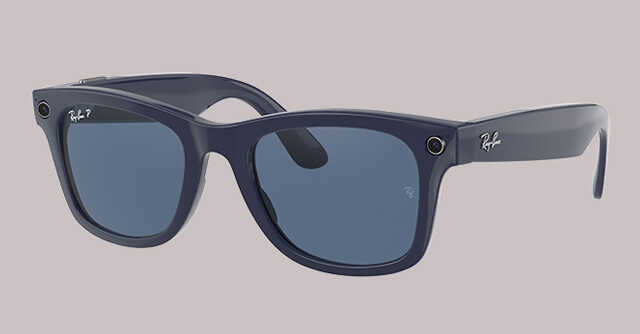
Facebook ties up with Ray Ban to launch smart glasses that see, listen, take photos


Imagine using a pair of glasses that not only protect your eyes but also can take your calls, share photos and videos and listen to your voice commands like 'take a video'.
The world's largest social networking site Facebook has done just that by introducing a pair of smart glasses in partnership with the iconic Ray Ban of the Aviator glasses fame.
Christened 'Ray Ban Stories', the smart glasses are priced at $299 upwards, and available in 20 style combinations. They are currently are available for purchase online and in select retail stores in the US, Australia, Canada, Ireland, Italy, and the UK. Facebook has not announced an India plans for these smart glasses.

The glasses have two 5MP cameras on either side, which can be used to take photos. They also have microphones for taking calls and listening to podcasts, music etc. Gesture controls will help navigate through these functions, while hard-wired LED lights are fitted too, to inform other users when the camera is active.
The Ray Ban Stories have three beamforming microphones that use noise-suppression algorithms, similar to what’s seen on true wireless earbuds today. Beamforming microphones use a digital signal processor (DSP) to better understand where audio is coming from, and are typically used to cut out environmental noise in consumer devices.
“Achieving high-quality audio was not a foregone conclusion. We used a bass reflex system, and there were early challenges in getting the speaker porting to fit into the glasses constraint. The answer came with combining great hardware with great software on top of it — and a bit of persistence,” the company said in a blog post on Friday.

To use the smart glasses, users will have to download the Facebook View app and will require a Facebook account as well. The app will allow users to import images from the Ray Ban Stories to Instagram, Twitter, WhatsApp, TikTok, Snapchat and other apps. Ray Ban’s Wayfarer/Wayfarer Large, Round and Metro designs will be used for these smart glasses, and they’ll be sold in five colours.
Further, the social media giant has also built its own voice assistant for the glasses. A physical button allows users to trigger the assistant and use commands like, “Hey Facebook, take a video” for hands-free control.
Facebook had announced the partnership with Ray Ban just over a year ago, and registered a patent with the Federal Communications Commission (FCC) later. However, while earlier reports speculated that the smart glasses would have augmented reality (AR) features, the Ray Ban Stories have cameras for regular photo capture only.

To avoid privacy violation issues, Facebook said in its blog that it has consulted a host of advocacy groups on the privacy aspect of these glasses. In addition, while the privacy policy for the glasses tells users that the company will be collecting data on how users use the Ray Ban Stories, it claims to not analyze this data in order to target advertisements at users.
Facebook has also introduced a power switch to turn off the cameras and microphone. The capture LED is hardwired to the camera and shines a white light when you’re taking photos or videos to notify people nearby. Controls in the Facebook View app help you customize your experience—you determine things like your personal preferences for importing photos and videos and when and where you share content you capture with the glasses.
To be sure, Facebook isn’t the only company trying to bring smart glasses to the mainstream. Tech giant Google started working on the Google Glass back in 2013, but eventually converted the device into an enterprise device. Facebook’s chief competitor for the glasses though is Snapchat, which has been selling augmented reality glasses for a few years now.

Snapchat introduced the fourth generation of its AR-capable Snapchat Spectacles in May this year. While Facebook’s smart glasses are not coming to India right now, Snapchat had launched the third generation of its Spectacles in India as well, while audio giant Bose had launched a device called Frames in 2019.
Jaipal Singh, Research Manager at market research firm International Data Corporation (IDC), said that devices we have seen so far are “first generation devices” and though smart eyewear is important, this is just the beginning. “The Facebook device you’re seeing is just a first-generation device. There’s a lot to add and build in eyewear. Before this there were hardly any companies working on it, but now we have companies who are thinking about putting AR and VR together into eyewear,” he said. Singh said that shipments for devices like the Snapchat Spectacles and Bose Frames in India are still in the “few hundreds”, which is a sign that eyewear is yet to mature.
Augmented reality and virtual reality (VR) glasses have also been produced by American startups like Magic Leap, but most have failed so far. In October 2017, Snapchat’s CEO, Evan Spiegel, said that the company had sold “over 150,000” units of the Spectacles, roughly a year after they first launched. While the company has continued producing these glasses, its overall focus has shifted to creating an augmented reality platform rather than selling these consumer devices. In 2019, Spiegel said that it would likely be a decade before consumers accepted such devices.

For Facebook, the idea behind launching the Ray Ban Stories could be the same as Snapchat. The company also owns virtual reality firm Oculus, and it has showcased research meant to create ambient computing devices, which will allow users to interact with AR and VR devices through gestures. In April this year, Facebook showcased wrist-band based AR controllers, which could read the signals the human brain sends to our hands through the neurons.
